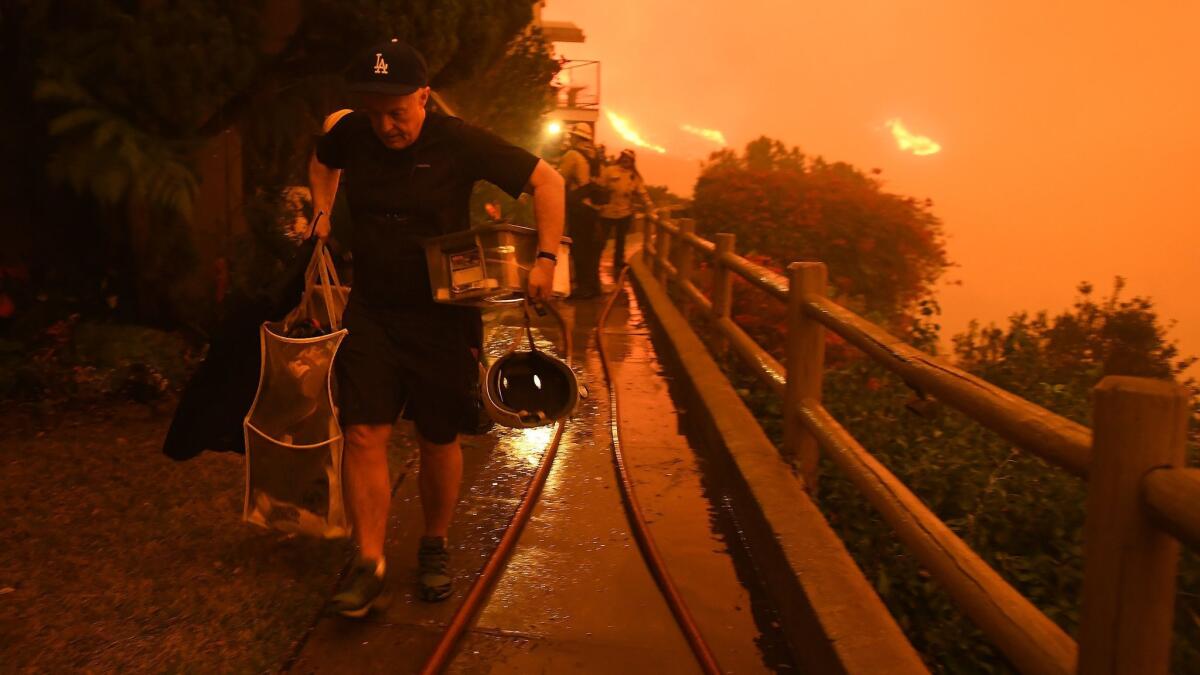L.A. County and Malibu will study the Woolsey wildfire response in a ânew era of threatâ

The city of Malibu and the county of Los Angeles will begin examining the response to and recovery from the Woolsey fire, the fast-moving and most destructive wildfire in recent Southern California history.
Citing the ânew era of threat from wildfires,â the Los Angeles County Board of Supervisors voted unanimously last month to convene a panel to review the cause of the Woolsey fire, the deployment of firefighters, evacuation procedures and the communication among first responders, police and municipalities.
For the record:
12:15 p.m. Jan. 2, 2019An earlier version of this article said the Malibu City Council had designated two members to a special committee to look at the cityâs response to the Woolsey fire. The council discussed designating the members. Also, an earlier version said the Woolsey fire was contained on Thanksgiving Day. It was contained Nov. 21, the day before Thanksgiving.
The fire broke out Nov. 8 and quickly spread to more than 96,000 acres, killing three people and destroying more than 1,600 structures before it was contained on Nov. 21.
Officials have said thousands of homes were saved, but residents in the flamesâ path have criticized firefighters and authorities for a slow response, a paucity of firefighting resources and conflicting evacuation information.
âItâs clear that a comprehensive review of the countyâs response and recovery procedures will be valuable to ensure that we are increasingly better prepared for the heightened fire risk we now face, as well as to answer questions raised by my constituents,â said Supervisor Sheila Kuehl, whose district includes several communities in the Santa Monica Mountains directly affected by the blaze.
The countyâs committee will be made up of law enforcement, state and local firefighting agencies, and representatives from cities including Malibu, Calabasas and Agoura Hills. The committee will work with the countyâs chief executive, who will also hire an outside consultant to study the overall Woolsey fire response.
The supervisors will receive progress reports every 90 days detailing strengths and weaknesses of the disaster response and recommendations for handling future catastrophes.
In Malibu, where about 440 homes were destroyed in the fire, the City Council unanimously voted last month to create its own special committee to begin looking at the cityâs response to the fire as well as ways to improve evacuations and prepare for future events.
âIt was a disaster, on every level. It was a total disaster. All of our systems werenât up for this because we werenât ready,â Councilman Mikke Pierson said at the meeting. âIâm much more interested in how we get ready and how we improve.â
The scope and structure of Malibuâs special committee was unclear, but the City Council discussed designating two members â Skylar Peak and Rick Mullen â to lead the group. Mullen said the pair could propose specific subgroups with narrower tasks, such as reviewing evacuation plans. Evacuations for Malibuâs eastern end, which was mostly untouched in the Woolsey fire, were a priority.
The City Council is expected to finalize the special committee at its Jan. 14 meeting. Meanwhile, Malibu will create a website where residents can submit suggestions for disaster response and recovery.
âThe entire City Council and I are absolutely committed to helping the residents of Malibu rebuild and get back on their feet as quickly and safely as possible,â Mayor Jefferson Wagner said in a statement.
âLike so many of you, my house burned down, so I am going through this together with you. Part of the healing process includes understanding what happened and why it happened, and making improvements for the future, which is why the formation of a disaster committee is so important.â
Twitter: @MattHjourno
More to Read
Sign up for Essential California
The most important California stories and recommendations in your inbox every morning.
You may occasionally receive promotional content from the Los Angeles Times.











